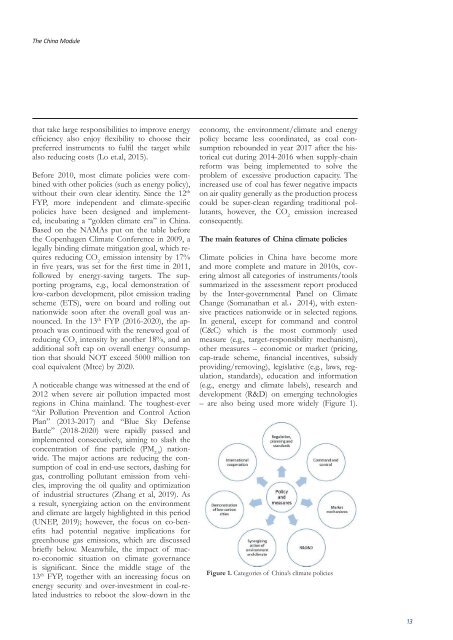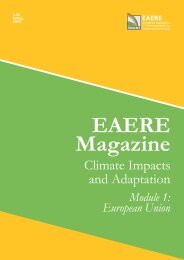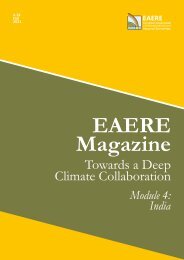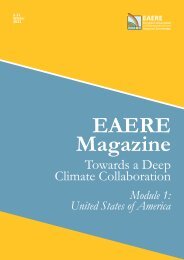You also want an ePaper? Increase the reach of your titles
YUMPU automatically turns print PDFs into web optimized ePapers that Google loves.
The China Module<br />
that take large responsibilities to improve energy<br />
efficiency also enjoy flexibility to choose their<br />
preferred instruments to fulfil the target while<br />
also reducing costs (Lo et.al, 2015).<br />
Before 2010, most climate policies were combined<br />
with other policies (such as energy policy),<br />
without their own clear identity. Since the 12 th<br />
FYP, more independent and climate-specific<br />
policies have been designed and implemented,<br />
incubating a “golden climate era” in China.<br />
Based on the NAMAs put on the table before<br />
the Copenhagen Climate Conference in 2009, a<br />
legally binding climate mitigation goal, which requires<br />
reducing CO 2<br />
emission intensity by 17%<br />
in five years, was set for the first time in 2011,<br />
followed by energy-saving targets. The supporting<br />
programs, e.g., local demonstration of<br />
low-carbon development, pilot emission trading<br />
scheme (ETS), were on board and rolling out<br />
nationwide soon after the overall goal was announced.<br />
In the 13 th FYP (2016-2020), the approach<br />
was continued with the renewed goal of<br />
reducing CO 2<br />
intensity by another 18%, and an<br />
additional soft cap on overall energy consumption<br />
that should NOT exceed 5000 million ton<br />
coal equivalent (Mtce) by 2020.<br />
A noticeable change was witnessed at the end of<br />
2012 when severe air pollution impacted most<br />
regions in China mainland. The toughest-ever<br />
“Air Pollution Prevention and Control Action<br />
Plan” (2013-2017) and “Blue Sky Defense<br />
Battle” (2018-2020) were rapidly passed and<br />
implemented consecutively, aiming to slash the<br />
concentration of fine particle (PM 2.5<br />
) nationwide.<br />
The major actions are reducing the consumption<br />
of coal in end-use sectors, dashing for<br />
gas, controlling pollutant emission from vehicles,<br />
improving the oil quality and optimization<br />
of industrial structures (Zhang et al, 2019). As<br />
a result, synergizing action on the environment<br />
and climate are largely highlighted in this period<br />
(UNEP, 2019); however, the focus on co-benefits<br />
had potential negative implications for<br />
greenhouse gas emissions, which are discussed<br />
briefly below. Meanwhile, the impact of macro-economic<br />
situation on climate governance<br />
is significant. Since the middle stage of the<br />
13 th FYP, together with an increasing focus on<br />
energy security and over-investment in coal-related<br />
industries to reboot the slow-down in the<br />
economy, the environment/climate and energy<br />
policy became less coordinated, as coal consumption<br />
rebounded in year 2017 after the historical<br />
cut during 2014-2016 when supply-chain<br />
reform was being implemented to solve the<br />
problem of excessive production capacity. The<br />
increased use of coal has fewer negative impacts<br />
on air quality generally as the production process<br />
could be super-clean regarding traditional pollutants,<br />
however, the CO 2<br />
emission increased<br />
consequently.<br />
The main features of China climate policies<br />
Climate policies in China have become more<br />
and more complete and mature in 2010s, covering<br />
almost all categories of instruments/tools<br />
summarized in the assessment report produced<br />
by the Inter-governmental Panel on Climate<br />
Change (Somanathan et al.,2014), with extensive<br />
practices nationwide or in selected regions.<br />
In general, except for command and control<br />
(C&C) which is the most commonly used<br />
measure (e.g., target-responsibility mechanism),<br />
other measures – economic or market (pricing,<br />
cap-trade scheme, financial incentives, subsidy<br />
providing/removing), legislative (e.g., laws, regulation,<br />
standards), education and information<br />
(e.g., energy and climate labels), research and<br />
development (R&D) on emerging technologies<br />
– are also being used more widely (Figure 1).<br />
Figure 1. Categories of China’s climate policies<br />
13













